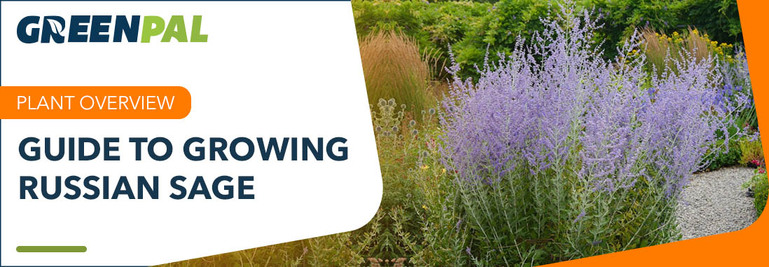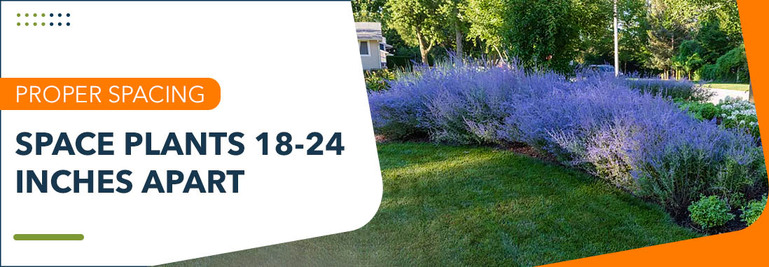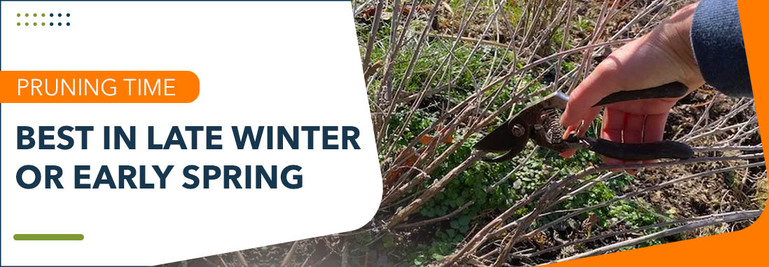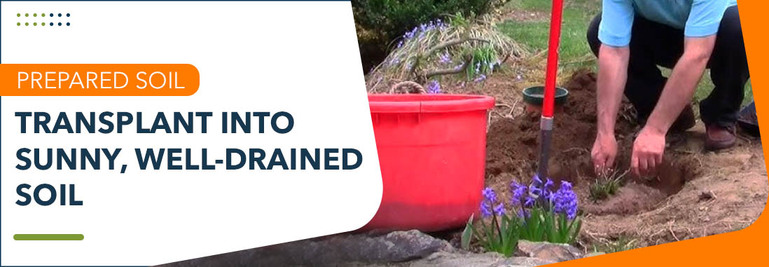Russian Sage:
A Guide to Growing and Caring for Salvia Yangii
Russian Sage (Salvia yangii) adorns many gardens — it's beautiful and easy to maintain. For years, plant taxonomists classified Russian Sage as a member of the mint family and not a sage — despite its name — but DNA tests changed all this. While its name seems confusing, its popularity remains unscathed.
Adorned with clusters of lavender-blue flowers, which bloom from mid to late summer until fall, this drought-tolerant and deer-resistant perennial is a go-to for xeriscaping and areas of the country where droughts are common.
Key Takeaways
|
|
|
|
|
|
What USDA Zones does Russian Sage grow in?
Russian Sage thrives in USDA zones 5 to 9 and can grow in zones 3 and 4 with some preparations for winter.
Another weird fact about Russian Sage is that it's not from Russia. It originated in Afghanistan, Pakistan, Tibet, and western China. Its ability to thrive in such arid climates allows it to thrive in similar regions in the United States, where it can enjoy full sunlight and good soil drainage.
Want to keep your lawn and garden healthy? Sign up for GreenPal for free today!

How to Plant Russian Sage
Russian Sage loves well-drained soil and sun. It's not a fan of soggy soil. Space plants 18 inches to 2 feet apart for adequate air circulation between plants and room for root expansion. Russian Sage rises to 3 to 5 feet tall and spreads about 2 to 4 feet across. To plant Russian Sage:
1. Select a location that receives full sun. Russian Sage prefers the heat.
2. Prepare the soil by adding compost if necessary to improve drainage.
According to the University of Nebraska's Institute of Agriculture and Natural Resources, adding organic matter like compost or well-rotted manure improves soil drainage by increasing soil aggregation allowing varied pore sizes.
3. Dig a hole that's wider than the width of the root ball and just as deep.
4. Set the plant in the hole so the crown, where the stems join the root, is level with the soil surface.
5. Fill the hole with soil, gently firming it around the base.
6. Water thoroughly to settle the soil.
To grow Russian Sage in a pot, use a well-draining potting mix and make sure the pot has bottom holes for drainage. It's an elegant addition for patios and balconies and easy to keep healthy due to its drought tolerance.
Want to keep your lawn and garden healthy? Sign up for GreenPal for free today!

Varieties of Russian Sage
While retaining the adaptable, drought-tolerant, and long-flowering characteristics that have made it a staple of American gardens and landscapes, several Russian Sage varieties are often sought. 'Denim and Lace' Russian Sage is one of the most popular.
It grows about two to three feet tall and wide and blooms from midsummer to fall. Many gardeners love 'Denim and Lace' since it's sturdier and shorter than other varieties.
One of the more widely available, compact varieties is 'Little Spire,' which grows only 2 feet tall. This variety proves excellent for smaller gardens or container planting. The 'Blue Spire' variety might reach 5 feet if well maintained, but its average height is between 3 and 4 feet.
All of the varieties of Russian Sage discussed here are highly drought-resistant; they all provide structure and unique, colorful additions to a perennial border or mixed bed. Pot them, too. They're just as gorgeous on their own.
Russian Sage Care and Maintenance

With proper care and maintenance, you can ensure that your Russian Sage thrives and remains a valuable asset to your garden for many seasons. Pruning Russian Sage is an essential component of care, and early spring or late winter is the best time to do it.
You can prune the plant back to an eventual height of about 6 to 8 inches above ground level in late winter or early spring.
Pruning Russian Sage promotes growth with a thicker mass of foliage and abundant flowering.
Want to keep your lawn and garden healthy? Sign up for GreenPal for free today!
Location is the key to success with Russian Sage. It craves the sun. Don't overdo watering. Russian Sage prefers dry soil. Water thoroughly but infrequently (perhaps a little more in the first growing season), allowing the soil to completely dry between waterings.
Russian Sage struggles to thrive in wet growing conditions, also referred to as "wet feet." According to the University of Kentucky Cooperative Extension Service, some possible ways to identify wet feet include:
Death at the top of the flower and continues backward to the root (dieback).
Yellowing, wilting, or browning of foliage — or a combination of these.
Browning and death of deeper roots, while surface roots appear healthy.
Avoid over-fertilizing: like many beautiful perennials, Russian Sage needs light care, but it's often over-cared for, causing it harm.
Mulching around the base of the plant to retain soil moisture and reduce weed growth is perfectly acceptable – except don't mulch too close to the stems, or else you might end up promoting rot.
And what about staking Russian Sage? It is only necessary if you live in a windy area.
Russian Sage is moved in the spring or fall when temperatures are more relaxed. Moving involves digging around the root ball to dig it up, or most of it, and transplanting it into a hole in well-prepared soil, preferably sunny and well-drained. Water well after transplant.
Want to keep your lawn and garden healthy? Sign up for GreenPal for free today!
Growing Russian Sage from Seeds

It takes a long time to grow Russian Sage from seeds because of its sluggish germination, but keep at it: it's worth the patient effort. Start seeds indoors 6 to 8 weeks before the last fall frost: sow the seeds in a seed-starting mix and cover lightly with soil. Keep them moist and in a warm, sunny location.
Russian Sage's Medicinal Benefits
Russian Sage is also known for its medicinal properties. North Carolina State's Extension service has this to say about the uses of Russian Sage:
"In many Asian countries, this plant has been used for treating medical conditions such as diabetes, dysentery, fever, and scabies. In Pakistan, it is used as an anti-inflammatory, analgesic, and antibacterial product."
Its plant extract is used for treating coughs and colds and is often used in teas, ointments, and balms.
Russian Sage and Pollinators
Russian Sage also makes a popular option for those looking to create a habitat for pollinators. Hummingbirds, leaf-cutting bees, honey bees, and carpenter bees all benefit from the nectar of Russian Sage.
Adding Russian Sage to a pollinator-friendly garden is a great way to help native bee species.
Want to keep your lawn and garden healthy? Sign up for GreenPal for free today!
Russian Sage: Frequently Asked Questions

Where is the best place to plant Russian Sage?
It's best to place Russian Sage in an area with medium to dry soil to avoid rot and in an area that receives at least 6 hours of full sunlight.
Is Russian Sage invasive?
This question is a point of debate. After searching several articles from experts and homeowners alike, many suggest that Russian Sage is not invasive, but, given the right conditions, Russian Sage can self-spread. A few sources we read noted that the plant seemed invasive.
How big does Russian Sage get?
While varieties of Russian Sage may trend smaller, the average Russian Sage grows between 3 to 5 feet tall and 2 to 4 feet wide.
Is Russian Sage good for anything?
Russian Sage's heat, drought, and pest tolerance make it a top pick for many looking to beautify their garden. Plus, Russian Sage is great for pollinators and has medicinal benefits.
What does Russian Sage repel?
Typically, deer avoid perennials with blooms that put off an aroma.
Does Russian Sage come back every year?
Yes. While annuals die in the winter and must be replanted, perennials like Russian Sage return yearly and don't have to be replanted.
What is the lifespan of Russian Sage?
As a perennial, Russian Sage can last indefinitely if well cared for, divided and replanted.
Does Russian Sage smell?
Russian Sage puts off a menthol scent that helps repel deer.
Quick Overview
Aspect |
Details |
USDA Zones |
Thrives in zones 5-9; can grow in zones 3-4 with winter preparation. |
Ideal Conditions |
Full sun, well-drained soil, drought-tolerant, and deer-resistant. |
Planting Tips |
Space 18-24 inches apart; add compost to improve drainage; water thoroughly after planting. |
Varieties |
'Denim and Lace' (2-3 ft tall), 'Little Spire' (2 ft tall), 'Blue Spire' (up to 5 ft tall). |
Care & Maintenance |
Prune to 6-8 inches in early spring; water infrequently; avoid over-fertilizing. |
Pollinator Benefits |
Attracts hummingbirds, bees; beneficial for pollinator gardens. |
Medicinal Uses |
Used for treating diabetes, dysentery, fever, scabies; anti-inflammatory, analgesic, antibacterial. |
Russian Sage is a drought-tolerant perennial, florally beautiful, and easy to care for. There are two things to know about it: grow Russian Sage in full sun and provide good drainage. Give it space to droop or hedge it in. As tempting as it may seem, don't water it too much — it will cause more harm than good.





 Share
Share












